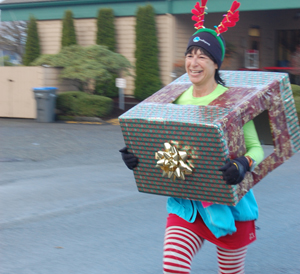Health Nut: Hot Tips for Cold Winter Workouts

By Kelly Turner
Photo at right: Pre-run warm-ups are gifts that keep on giving. Photo by Carolyn Price
There’s more to worry about than wiping out on a patch of ice or mastering your snot-rocket mid-run when winter hits your workouts. Knowing the effects of colder temperatures on your body and performance can help you prepare and lessen the impact on your body so you can enjoy the great outdoors year round.
Warming up is always important, but it becomes especially so when the temperature drops. Not warming up before a chilly run can be a shock to your body, causing muscles and joints to feel tighter and become more prone to injury.
Warm up for 5–10 minutes inside, so you can loosen your muscles and joints and raise your heart rate without the cold weather interfering. Stretching your muscles is like stretching taffy — warm taffy stretches and cold taffy snaps, so make sure the body is thoroughly warmed up before you head outside.
When your body is exposed to extreme temperatures, it reacts by regulating your core temperature. In cold weather, your body wants to conserve heat, and one way it does this is by constricting blood vessels in peripheral tissues, like your limbs, reducing the amount of heat that leaves your core. Because of this, your heart must work that much harder to pump blood through those constricted vessels, causing an increase in your heart rate.
Normally, an increase in heart rate equates an increase in calorie burn, but when your body is warm a few minutes into your workout, this effect will be less obvious and the increase in calorie burn is negligible.
Fun fact: According to the American Council on Exercise (ACE), you burn 400 calories per hour from the act of shivering.
When your body is exposed to cold, the rate at which you lose heat also speeds up. Losing heat faster than your body can create it can result in hypothermia, which can be life threatening. Your arms and legs will take care of themselves. Remember that blood flow is restricted to the limbs in cold conditions, so keeping your core warm is what’s important. Wear an extra layer, like a vest or light jacket, around your middle to really protect those vital internal organs. The most heat escapes out of your head, so trap body heat inside where it belongs by wearing a hat. In super cold temperatures, wear gloves to protect fingers from the elements.
Much more heat is lost when you’re wet, so while it may sound counter-intuitive, keep layers to a minimum and make sure they are made from a sweat-wicking material to reduce dampness. This is another advantage to warming up inside—you’re already warm before you head outside, so you don’t need as many layers to be comfortable.
Fun fact: It takes more energy to cool your body down during hot weather than it does to warm it up during cold weather.
Don’t let winter weather send your workouts indoors. In fact, heading outdoors for your workout when temperatures drop can help strengthen your immune system and prevent catching a cold or flu, so properly prepare and hit the frozen ground running.
Kelly Turner is a Seattle-based ACE certified personal trainer and fitness writer. You can contact her at Kellyturnerfitness@gmail.com. Twitter: @KellyTurnerFit Instagram:
KellyTurner26




George Godin, 1 year ago
This is such a very informative post. I really didn’t know that we burn 400 calories per hour from the act of shivering. I believe that one way also to help us burn calories is by exercising. If we exercise, we will not just burn our calories, but also, we will become more fit and healthy.